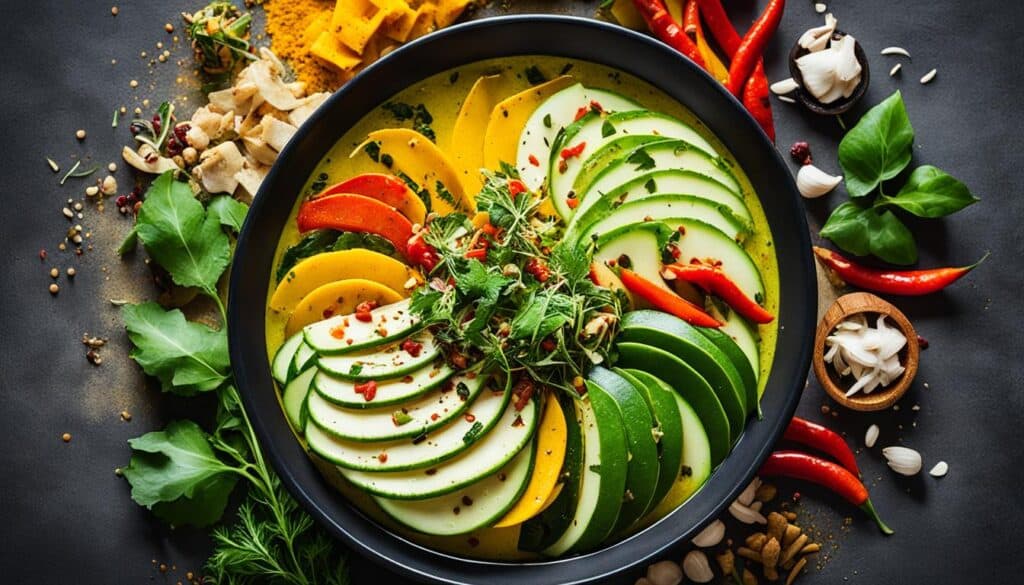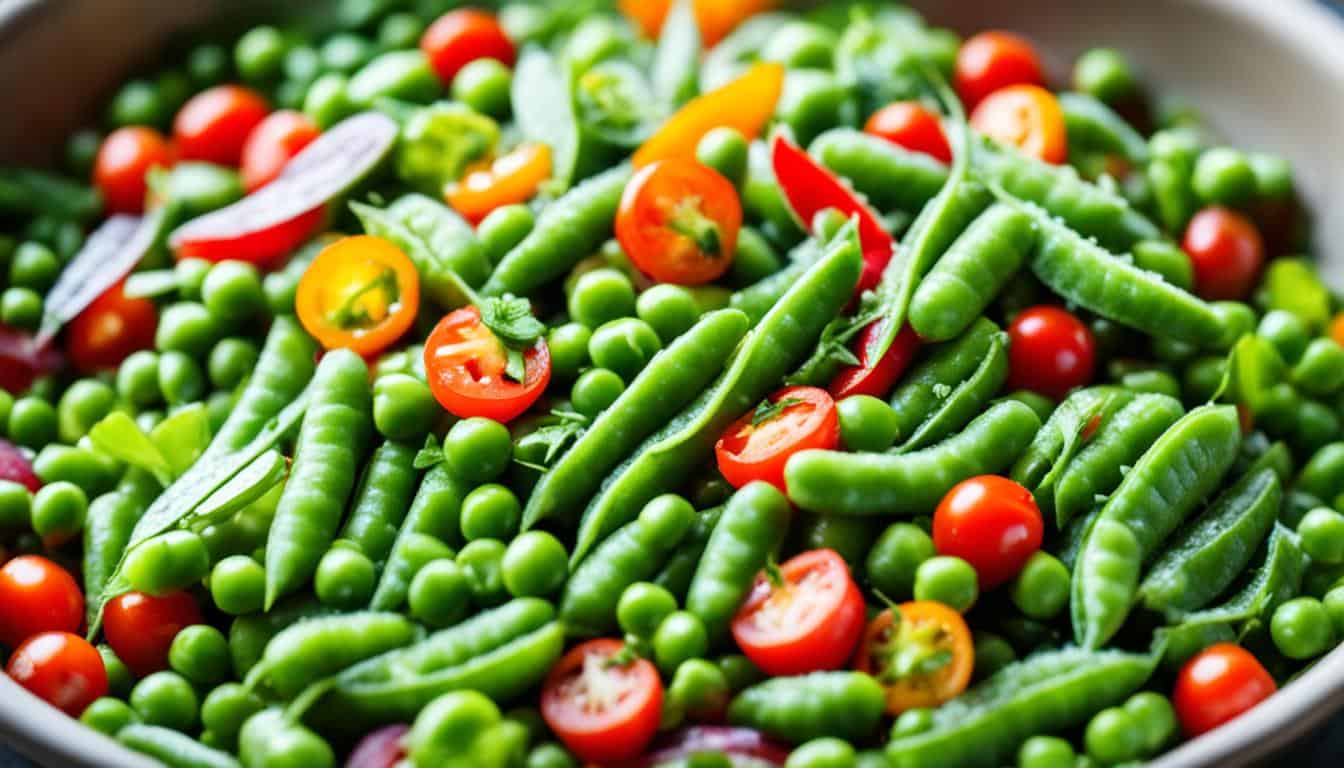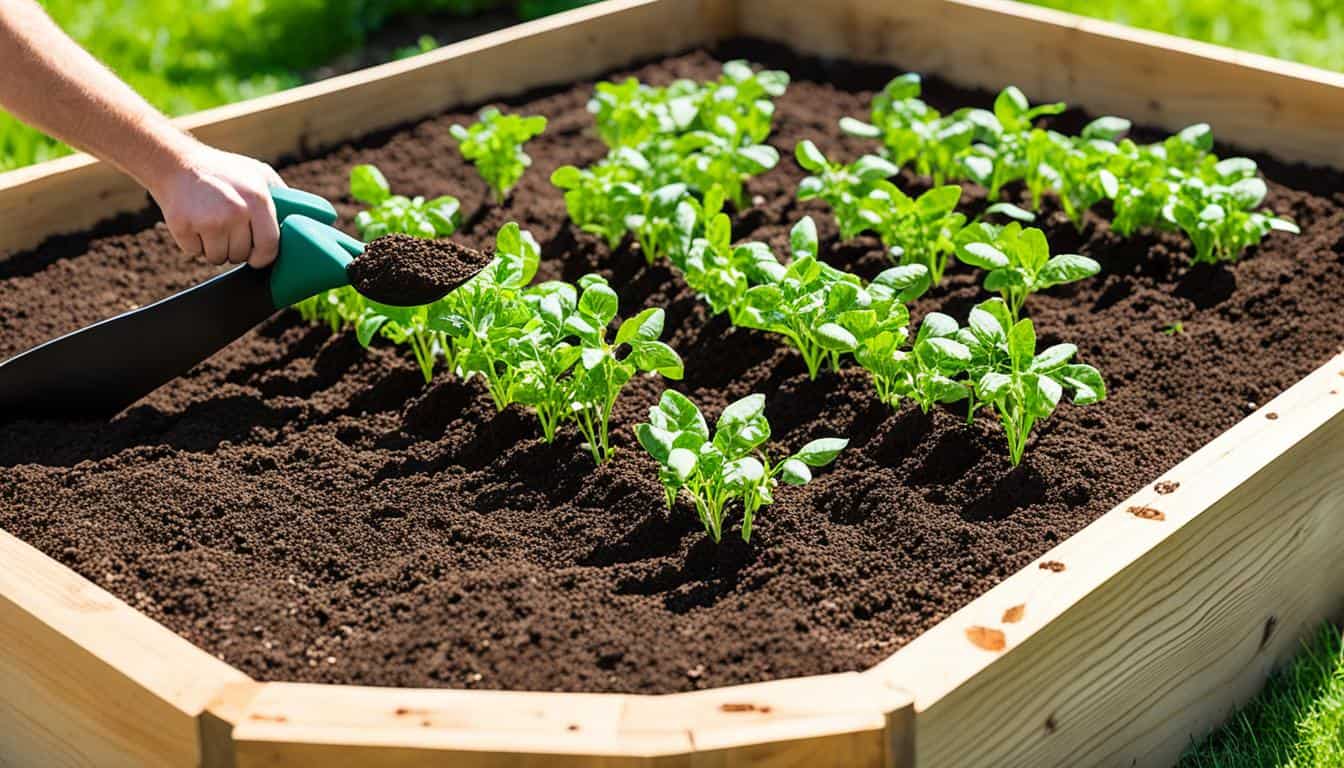Did you know that ridge gourd, also known as turai, is not just a vegetable but also a versatile and nutritious powerhouse that offers a wide range of health benefits? This unassuming vegetable, belonging to the cucumber family, has made its way into the hearts and kitchens of people across Indian, Chinese, and Vietnamese cuisines. Let’s delve into the wonders of turai and discover why it’s worth adding to your vegetable repertoire.
Key Takeaways:
- Turai, also known as ridge gourd, is a versatile and nutritious vegetable that is popular in Indian, Chinese, and Vietnamese cuisines.
- It is low in calories, high in fiber, and rich in minerals, vitamins, and antioxidants.
- Turai aids in digestion, weight loss, blood sugar control, and has medicinal properties.
- It can be incorporated into various dishes, such as curries, stir-fries, and soups.
- When buying and storing turai, choose fresh and tender ones and store them in the refrigerator.
Turai ki Subzi – A Flavorful Curry with Nutritional Benefits
Turai ki subzi, also known as ridge gourd curry, is a flavorful and nutritious dish made with turai as the main ingredient. It is commonly prepared in North India and goes well with both roti and rice.
Turai, or ridge gourd, is rich in vitamins, minerals, and antioxidants, making it an excellent addition to a healthy diet. This vegetable is low in calories and packed with nutrients. It is a great source of dietary fiber, which aids digestion and promotes a healthy gut.
To make turai ki subzi, start by heating oil in a pan and adding cumin seeds. Once they start spluttering, add finely chopped ginger and garlic, and sauté until fragrant.
Next, add finely chopped onions and cook until they turn golden brown. Now, add finely chopped tomatoes and cook until they become soft and mushy.
Once the tomatoes are cooked, add turmeric powder, red chili powder, coriander powder, and salt as per taste. Mix well and cook for a couple of minutes.
Now, add the ridge gourd pieces and mix everything together. Cover the pan and let it cook on low heat for about 10-15 minutes, or until the ridge gourd becomes tender.
Once the ridge gourd is cooked, squeeze in some fresh lime juice for a tangy flavor. Garnish with freshly chopped cilantro before serving.
This delicious and nutritious turai ki subzi is ready to be enjoyed with hot rotis or steamed rice.
Health Benefits of Turai
Turai, or ridge gourd, offers numerous health benefits. It is not only a versatile vegetable in cooking but also a powerhouse of nutrition. Let’s explore the various ways turai can contribute to your overall well-being.
1. Weight Loss
If you’re on a weight loss journey, ridge gourd can be a valuable addition to your diet. It is low in calories and high in fiber, which helps you feel fuller for longer, reducing the chances of overeating. Incorporating ridge gourd into your meals can support your weight loss goals.
2. Diabetes Control
Ridge gourd has been traditionally used to manage diabetes. It contains a compound called charantin, which helps regulate blood sugar levels. Consuming ridge gourd regularly may help control your blood glucose levels naturally.
3. Digestive Health
With its high fiber content, ridge gourd promotes healthy digestion. Fiber adds bulk to your stool, preventing constipation and promoting regular bowel movements. Including ridge gourd in your meals can improve your digestive health.
4. Anti-Inflammatory Properties
Ridge gourd possesses anti-inflammatory properties due to its antioxidants and phytochemicals. These compounds help reduce inflammation in the body, which may contribute to chronic diseases such as heart disease and arthritis.
5. Cooling and Hydrating
Ridge gourd is known for its cooling properties, making it a popular vegetable during hot summer months. It helps reduce body heat and keeps you hydrated. Including ridge gourd in your diet can help beat the summer heat.
6. Hair and Skin Care
Ridge gourd offers benefits for both hair and skin. It contains essential nutrients like vitamins A, C, and E, which promote healthy hair and skin. It can be used in hair masks and face packs to nourish and rejuvenate your skin and hair.
Tips for Buying and Storing Turai
When it comes to choosing the perfect ridge gourd, there are a few key factors to consider. Look for fresh and tender ridge gourds with vibrant green color. The pods should be firm to the touch, indicating their freshness. Check the stems to ensure they are intact and healthy, as any damage can affect the overall quality of the ridge gourd.
While the presence of ridges is a characteristic feature of ridge gourd, it’s essential to find a balance. The ridges should be present but not excessively bumpy or defined, as this could indicate matured ridge gourd. Opt for ridge gourds with a smooth, slightly raised surface, as they tend to be young and more flavorful.
Once you’ve picked out the perfect ridge gourds, it’s important to store them properly to maintain their freshness. Place the ridge gourds in the vegetable section of your refrigerator, ideally in a perforated plastic bag to allow for proper airflow. This helps to retain their freshness for a longer period.
Remember to use the ridge gourds within 2-3 days of purchase for optimal taste and texture. Over time, ridge gourds can become limp and lose their crispness, so it’s best to consume them while they are still at their peak.
Before cooking, prepare the ridge gourd by peeling off the tough outer skin. You can use a peeler or a knife to remove the skin, ensuring that all the rough ridges are completely removed. Once peeled, cut the ridge gourd into small pieces, ready to be added to your favorite curries, stir-fries, or other delicious dishes.
Choosing the perfect ridge gourd is the first step towards a delicious and nutritious meal.
Ridge Gourd Cultivation and Varieties
Ridge gourd, a popular vegetable in Asia, is cultivated extensively in China, Vietnam, and various regions of India. It is highly valued as an important commercial crop due to its high yield and low investment requirements.
Ridge gourd vines have a climbing habit and need support for their proper growth and development. Farmers often provide trellises or stakes for the vines to climb on, ensuring better access to sunlight and improved air circulation.
There are several improved varieties of ridge gourd available, each specific to different regions and climates. In India, some popular hybrid varieties include Pusa Nasdar, Desi Chaitali, and Co-1. These varieties have been developed to withstand diseases, pests, and adverse weather conditions, resulting in higher yields and superior quality produce.
Ridge gourd cultivation can be undertaken throughout the year with proper farm management practices and irrigation facilities. The vegetable can be grown in various settings, including pots, containers, backyards, poly houses, and greenhouses. The choice of cultivation method depends on the available resources and the specific requirements of the farmer.
Benefits of Ridge Gourd Cultivation
Ridge gourd cultivation offers several advantages to farmers:
- High yield potential
- Low investment requirements
- Tolerant to common diseases and pests
- Ability to grow in diverse climatic conditions
- Short duration crops, allowing for multiple harvests
- Commercial value in local and international markets
Comparison of Ridge Gourd Varieties
| Variety | Yield Potential | Susceptibility to Diseases | Adaptability to Climate |
|---|---|---|---|
| Pusa Nasdar | High | Resistant | Wide range |
| Desi Chaitali | Medium | Moderate | Specific to certain regions |
| Co-1 | High | Resistant | Wide range |
The table above compares the yield potential, susceptibility to diseases, and adaptability to different climates of three popular ridge gourd varieties. It provides farmers with valuable insights when selecting the most suitable variety for their specific farming conditions.
Ultimately, ridge gourd cultivation offers farmers the opportunity to grow a profitable crop with high market demand. It continues to play a significant role in Asian agriculture, contributing to food security and economic development.
Traditional Uses of Ridge Gourd in Ayurveda
Ridge gourd, a versatile vegetable treasured in ancient Ayurvedic diets, offers a myriad of benefits. Its cooling properties make it a valuable ingredient for balancing the Vata and Kapha doshas while controlling the Pitta dosha. This vegetable is not only delicious but also packed with essential nutrients, including vitamin C, riboflavin, and zinc. Furthermore, ridge gourd is rich in antioxidants, promoting overall health and well-being.
In Ayurveda, the skin of ridge gourd is particularly prized for its nutritive properties. Incorporating it into your diet can be as simple as adding it to fresh juices, cooking it with dal for a nutritious dish, or using it as a key ingredient in various traditional recipes.
Experience the wonders of ridge gourd in Ayurveda and harness its incredible health benefits.
Popular Ridge Gourd Recipes
When it comes to cooking with ridge gourd, there are several popular recipes from different regions that showcase its versatility and delicious flavors. Let’s take a closer look at some of these mouthwatering dishes:
1. Beerakaya Pachadi
Beerakaya Pachadi is a versatile chutney made with ridge gourd or its skin. This tangy and spicy condiment pairs well with rice, dosa, or rotis. It adds a burst of flavor and is a great way to use ridge gourd in a unique and delicious way.
2. Peerkangai Kootu
In Tamil Nadu, Peerkangai Kootu is a popular dish that combines ridge gourd with moong dal. This nutritious and comforting dish is a great accompaniment to rice or rotis. The combination of ridge gourd and dal creates a hearty and flavorful curry that is loved by many.
3. Turai Ki Sabzi
Turai ki Sabzi is a common vegetable dish in North India, especially during the summer season. It is cooked with a mix of spices including mango powder and asafoetida, giving it a tangy and aromatic flavor. This vibrant and flavorful curry is a perfect way to enjoy ridge gourd.
4. Masor Tenga
In Assamese cuisine, Masor Tenga is a popular fish curry made with tomatoes, ridge gourd, and lemon. The combination of tangy tomatoes and tender ridge gourd creates a flavorful and comforting curry that pairs well with steamed rice. This traditional dish is a must-try for seafood lovers.
5. Jhinge Chingri Posto
Bengali cuisine presents Jhinge Chingri Posto, a creamy prawn dish that combines ridge gourd with potatoes, poppy seeds, and traditional spices. The rich and aromatic flavors of this dish make it a favorite among Bengalis. It is often enjoyed with rice, creating a satisfying and flavorful meal.
| Recipe | Description |
|---|---|
| Beerakaya Pachadi | A versatile chutney made with ridge gourd or its skin, perfect for rice, dosa, or rotis. |
| Peerkangai Kootu | A nutritious curry that combines ridge gourd with moong dal, enjoyed with rice or rotis. |
| Turai Ki Sabzi | A vibrant and tangy vegetable dish made with ridge gourd, perfect for the summer season. |
| Masor Tenga | An Assamese fish curry with tomatoes, ridge gourd, and lemon, best paired with rice. |
| Jhinge Chingri Posto | A creamy prawn dish that combines ridge gourd, potatoes, and poppy seeds, enjoyed with rice. |
No matter which recipe you choose, these ridge gourd dishes are sure to impress with their unique flavors and nutritional benefits. So why not give them a try and explore the delicious world of ridge gourd?
Ridge Gourd’s Culinary Significance in Asian Cuisines
Ridge gourd, known for its versatility and mild flavor, is not only popular in Indian cuisine but also plays a significant role in various Asian cuisines. Let’s explore how this nutritious vegetable is incorporated into the culinary traditions of Japan, Vietnam, and the Philippines.
Japanese Cuisine
In Japan, ridge gourd, known as “jyagaimo,” is a common ingredient in a variety of dishes. It is often used in soups, such as the popular “tonjiru,” a hearty miso-based soup containing vegetables and pork. Ridge gourd is also stir-fried with other ingredients like tofu and mushrooms, adding a delightful crunch to the dish. Furthermore, it is pickled and enjoyed as a side dish or accompaniment to rice.
Vietnamese Cuisine
Ridge gourd, known as “mướp hương” in Vietnamese, is featured in a range of traditional dishes. In Vietnamese cuisine, ridge gourd is commonly used in salads, such as the refreshing “gỏi mướp” mixed with shrimp, herbs, and a zesty dressing. It is also a popular ingredient in spring rolls, contributing a crisp texture and subtle sweetness.
Filipino Cuisine
In the Philippines, ridge gourd, known as “upo,” is a staple vegetable used in various dishes. It is a key ingredient in the beloved Filipino soup “sinigang,” a sour soup typically made with pork, seafood, or beef. Ridge gourd adds a light and refreshing flavor to the soup. Another popular Filipino dish featuring ridge gourd is “pinakbet,” a vegetable stew cooked with shrimp paste. The addition of ridge gourd enhances the overall taste and texture of the dish.
As we can see, ridge gourd’s culinary significance extends beyond Indian cuisine. Its mild flavor and unique texture make it a versatile ingredient in Asian cooking, adding a delightful touch to soups, stir-fries, pickles, salads, and stews.
Ridge Gourd and the History of the Loofah Sponge
The connection between ridge gourd and the loofah sponge is fascinating. The scientific name for ridge gourd is Luffa acutangula, and its fibrous interior has been used to make loofah sponges for centuries. Traditional loofah fibers in India have long been treasured for their skin-enhancing properties even before cosmetic companies discovered them. The matured and dried version of ridge gourd is used to create the loofah sponge, which is known for its exfoliating and cleansing properties.
This shows the multifunctionality and importance of ridge gourd in different aspects of life.
Local Names and Cultural Significance of Ridge Gourd in India
Ridge gourd, known as turai in Hindi, takes on different local names across the diverse regions of India. In Tamil Nadu, it is called peerkangai, while in Andhra Pradesh and Telangana, it goes by beerakaya. In Kerala, it is referred to as peechinga. These local names reflect the regional variations and cultural diversity present in India.
Ridge gourd holds great cultural significance in Indian cuisine. It is a beloved vegetable used in a wide range of dishes across the country. From simple curries and stir-fries to traditional delicacies, ridge gourd adds its unique flavor and texture to elevate the taste of various preparations. Its versatility allows it to be used in both vegetarian and non-vegetarian dishes, making it a popular choice for meals enjoyed by people from different cultural backgrounds.
Beyond its culinary value, ridge gourd is deeply rooted in Ayurvedic traditions. It is highly regarded for its cooling properties, making it an ideal vegetable for summers. Ayurveda recognizes ridge gourd as a nourishing and balancing food that promotes physical and mental well-being. The vegetable’s high water content and fiber contribute to its cooling effect, helping to pacify excess heat in the body.
“Ridge gourd, or turai, holds a special place in Indian cuisine, reflecting the diverse cultural landscape of the country. Its local names and cultural significance showcase the rich culinary heritage and traditional practices associated with this versatile vegetable.”
The cultural significance of ridge gourd extends beyond its presence in Indian kitchens. It also plays a role in various festivals and religious rituals. In some communities, the ridge gourd vine is used as a decorative element during festive occasions to symbolize fertility and abundance. These cultural associations highlight the deep-rooted connection between food, tradition, and spirituality in Indian culture.
With its strong cultural significance, ridge gourd continues to be cherished and valued in Indian households. Its availability throughout the year and affordability make it an essential and versatile vegetable that is embraced by people of all walks of life. Whether enjoyed in a simple curry or incorporated into elaborate recipes, ridge gourd remains an integral part of Indian cuisine, celebrating the diverse flavors and culinary traditions of the country.
Conclusion
Turai, or ridge gourd, is a fascinating vegetable with numerous benefits and culinary uses. It has gained popularity due to its nutritional content and ability to adapt to various cuisines. Whether you’re exploring Asian flavors or incorporating it into your favorite recipes, turai offers a healthy and flavorful option.
In Asian cuisine, ridge gourd plays a significant role, adding a mild and versatile flavor to dishes. From Japanese soups to Vietnamese spring rolls, and Filipino stews, ridge gourd’s culinary significance is evident. Its presence in these cuisines highlights its adaptability and appeal.
Moreover, turai’s Ayurvedic significance cannot be overlooked. With its cooling properties and unique nutrients, it is considered beneficial for balancing doshas and promoting overall health. The vegetable is cherished in Ayurvedic traditions and valued for its Ayurvedic significance.
With ridge gourd, you have a lot to gain. Its benefits extend beyond its nutritional value. Whether you want to explore ridge gourd recipes, appreciate its role in Asian cuisine, or experience its Ayurvedic significance, turai is a vegetable worth incorporating into your veggie guide. So, go ahead, unlock the potential of turai, and enjoy its rich flavors and health benefits.










Leave a Reply